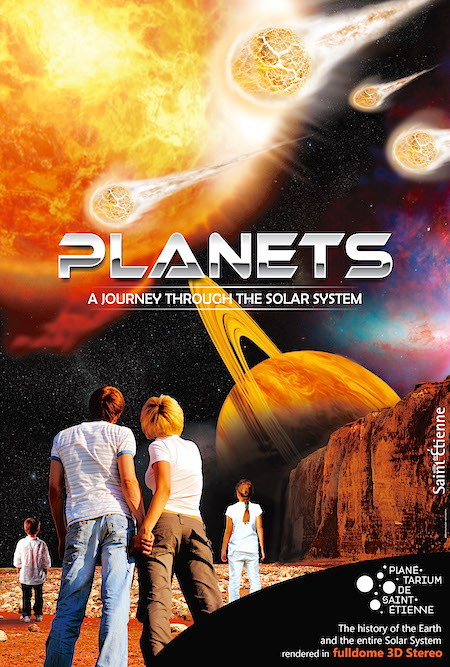A presenter-led show looking at the night sky from Indian Vedic culture. Witness the skies above India and learn about the Gods that move across the skies through the 12 constellations of their Zodiac.
Duration: 25 mins
Suitable for all ages
A presenter-led show looking at the night sky from Indian Vedic culture. Witness the skies above India and learn about the Gods that move across the skies through the 12 constellations of their Zodiac.
Duration: 25 mins
Suitable for all ages
This fulldome show is about the traditional picture book of the Christmas Story, offering a wonderful experience for children and adults in the Planetarium. It brings the traditional Christmas Story to life for you and your family. You accompany Mary and Joseph from the Annunciation by the angel Gabriel in Nazareth to the search for a room in overcrowded Bethlehem.
Stand before King Herod in his great palace, alongside the three Wise Men from the East. Visit the shepherds and their flocks in a field and, in a stable, find the child in a manger.
Duration: 27 minutes
Suitable for all ages.
To celebrate Shabbat 2019, we worked with the Chief Rabbi and Tribe to bring this fulldome film about Shabbat to over 30 schools across the UK.
Suitable for all ages, it runs for 11 minutes and you can see the full video by clicking below.

 The categorisation of Dwarf Planets splits the world into two parts: one that loved Pluto as planet and the others who preferred simpler cataloging of celestial bodies.
The categorisation of Dwarf Planets splits the world into two parts: one that loved Pluto as planet and the others who preferred simpler cataloging of celestial bodies.Show details
Duration: 15 min.
Audience: General
Audio: 5.1 Surround Sound (Separate channels available)
Narration: English, French, Russian, Dutch (Can be dubbed in other languages)
 A Tale of Scale is a delightful short feature in the format of a poem. This show is about the size comparison of Planets and Stars. This show achieves a very unique way of representing the size comparison. With the help of fun filled motion graphics, cute fable, rhyming script and melodious music, the show will put a smile on your face and is very much adored by young audiences and is suitable for all ages!
A Tale of Scale is a delightful short feature in the format of a poem. This show is about the size comparison of Planets and Stars. This show achieves a very unique way of representing the size comparison. With the help of fun filled motion graphics, cute fable, rhyming script and melodious music, the show will put a smile on your face and is very much adored by young audiences and is suitable for all ages!Show details
Duration: 5 min.
Audience: General

Suitable for all ages
Length: 25 min

Set on the surface of the Moon in the year 2081, a grandfather and granddaughter are watching a solar eclipse from the scenic cliffs overlooking their moon colony. They discuss the contrasts between the moon, the only home the granddaughter knows, and the Earth, where the grandfather has spent most of his life.
As they watch the Moon’s shadow move across the Earth, the grandfather tells stories of crashing asteroids, erupting volcanoes, roaring dinosaurs, and more. The stories are experienced by the viewers, beginning with a view through the telescope of the dynamic Earth; a stark contrast with the unchanging lunar landscape.
EARTH’S WILD RIDE is like many tales shared by grandparents over the centuries, except “the old country” is really another planet, always visible, but totally unlike the granddaughter’s world. While learning about eclipses, the ice age, Earth’s water cycle and differences between the Earth and Moon, the audience is taken on a roller-coaster-like ride through canyons of raging rivers and hot flowing lava. Adventure and appreciation for home fill this 20-minute journey back to the Earth.
Ages: All ages
Length: 20 mins
Also available in English*, Chinese (Mandarin), French, German, Hebrew, Italian, Korean, Polish, Russian, Spanish* and Turkish. * indicates subtitles available in that language.
 Out There: The Quest for Extrasolar Worlds
Out There: The Quest for Extrasolar WorldsOut There — The Quest for Extrasolar Worlds tells the story of how human curiosity has driven us to look outwards for millennia, to discover and explore new and distant worlds and to find the unfamiliar and extraordinary forms of life that could exist in the mysterious realms of the Universe.
The show is a production by The Swiss Museum of Transport Planetarium, directed and produced by Marc Horat, in cooperation with National Centre of Competence in Research PlanetS and ESO.
Out There — The Quest for Extrasolar Worlds will transport viewers from this world to entirely new and foreign ones. The show features the primitive science fiction of early civilisations, to the future space missions that will observe the Universe in greater-than-ever detail and travel to the surfaces and oceans of moons in our Solar System.
Show Type
All ages, 30 mins
 FORWARD! To the Moon
FORWARD! To the MoonKari Byron from Crash Test World and MythBusters launches us on a journey beyond the Earth towards a sustainable future in space. NASA’s 21st century Artemis program, named after the Greek moon Goddess and twin of Apollo, is the next step in our mission to explore the universe.
Length: 26 mins
All ages

Discover the fascinating landscapes of our Solar System.
Glide over the landforms of Mars, soar over the clouds of Jupiter and dive through the rings of Saturn.
Witness the violent beginnings of planet formation – as you try and avoid colliding with an asteroid!
Using real photographs taken by space probes as well as stunning computer generated imagery, the film presents a modern view of the Solar System in the dynamic context of its evolution.
Preview the full film below.
Length: 30min
KS3 – KS5 / Families / Adults
Also available in Arabic, Czech, French, Italian, Korean, Portuguese, Romanian, Spanish
Our award winning live astronomer show, suitable for all special and complex needs. SEN, SLD, PMLD…
Length: 15mins


Our highly acclaimed and popular ‘Islamic Astronomy’ show, presented by one of the UK’s most experienced astronomers.
This lively interactive show, goes back in time to the lands of Arabia where astronomers looked up at the night sky and made links between the heavens and scriptures within the holy book – The Quran
Show overview
Show details
Embark on a journey to the centre of the Milky Way and during seven minutes travel faster than light, from…
Length: 7mins
Cosmic art created by dying stars: 12 echoes of light from dramatic explosions in deep space…
Length: 5mins
The best of both worlds: an astronomer-led night sky curriculum linked show followed by a 360˚ film. Available with all performances…
Length: 30-45mins
“An explorer of the Cosmos has travelled too far… and can no longer find home”…
Length: 11mins
An inspirational endorsement to the joys of travel, touching lightly on social issues. The film attempts to stimulate the urge to discover and…
Length: 25mins
Take a breathtaking journey from the UK to the edge of the Solar System and beyond…
Length: 10mins
Key Stage 4 GCSE syllabus linked astronomer show, delivered by a teaching…
Length: 90mins
Dancers are uploaded into a computer‘s operating system and race against time to battle a virus and resolve…
Length: 4mins
At the dawn of time, the Universe comes into being and star fields begin to take form. The Hindu deity and…
Length: 6mins
How big is the distance between the Earth and the Sun – or between the Sun and the other planets?…
Length: 13mins
Do you know what an astronomer does? Today’s astronomer is not the lone observer of past centuries….
Length: 25mins
Inside a virtual, transparent dome the audience immersed in multicoloured ‘liquid light’…
Length: 5mins
A journey into dissolving space. Multicolored patterns expand and contract in a circular “breathing” way pushing the limits of resolution…
Length: 7mins
A breathtaking and unrivalled fulldome experience by professional artist Michel Gingras…
Length: 7mins
Stunning 360° film exploring the inner workings of global climate, using rich visualisations based on…
Length: 24mins
An exhilarating journey through time and space in search of our origins. Where did the atoms and molecules that make up our bodies…
Length: 26mins
Join scientists in the hunt for real aliens. How do we know which planets could harbour life? What are the requirements for…
Length: 25mins
With muscles and bones built for Earth, you’d be a superstar on the Solar System’s low-gravity worlds. Imagine bungee jumping into Space from an…
Length: 11 & 17 & 22mins
We live on a small planet revolving around a star similar in size, luminosity and location in the galaxy as countless others….
Length: 30mins
Travel through the Triassic, Jurassic and Cretaceous geological periods in search of the ancestors of modern-day birds…
Length: 30 & 44mins
The night sky, both beautiful and mysterious, has been the subject of campfire stories, ancient myths and awe for as long as…
Length: 30mins
When it comes to the health of our planet, each of us holds the power to make a significant difference. Just as…
Length: 26mins
Audiences are transported back 100 years and surrounded by the infamous WWI trenches. The horrors of the conflict are implied but never shown, making…
Length: 24mins
Starring Colin Baker as The Narrator. Time and space are collapsing from within and the Doctors are trapped by the darkest enemy they have ever faced….
Length: 35mins
The Alien Who Stole Christmas
Join Santa Clause and a concerned alien Mr. Freep, as they explore the solar system’s planets and meet the Christmas Eve needs of their fictitious…
The exploration of space is the greatest endeavour that humankind has ever undertaken. What does it take to be part of this incredible journey? What…
Length: 23mins